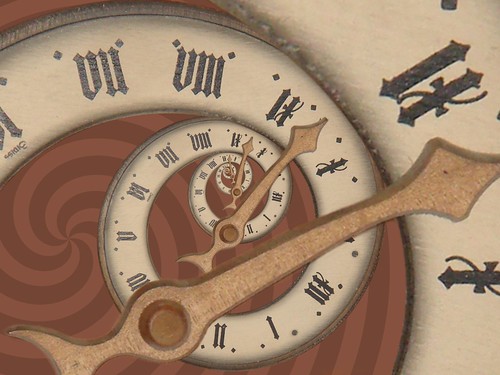 Up until the the 1960s, physicists believed that time worked the same forward as it did backward. For example, in classical physics, if you reversed the momentum of every particle in the universe, the universe would look exactly like a tape being run in reverse.
Up until the the 1960s, physicists believed that time worked the same forward as it did backward. For example, in classical physics, if you reversed the momentum of every particle in the universe, the universe would look exactly like a tape being run in reverse.
This of course begs the question: if the laws of physics work the same way forward as they do backward, why does time flow forward and not the other way around?
A new paper hints at an answer. The forward flow of time may not be an illusion. At the very least, we can now be sure time has an “arrow.” The laws of physics work differently in reverse. Now we just need to figure out why.
Up until the 1960s, scientists had assumed that if you reversed the flow of time, the universe would obey the same laws of physics. All you would have to do is replace matter with antimatter. In other words, reversing time was equivalent to switching left and right, and reversing the charge of particles.
(Quantum mechanics actually mucks this up a bit, because we have no idea if “observations,” which cause diffuse waves to collapse into point particles, are actually related to the concept of time. Still, quantum mechanics assumes a symmetry between forward and reverse time.)
But in 1964, James Cronin and Val Fitch discovered that the universe had other plans for reality. The decay of a class of particles called kaons didn’t fit the model. Antimatter seemed to have a very small, but fundamental difference from matter.
If this was true, it also meant that the laws of physics couldn’t work the same way forward as backward.
But this realization also created a big problem for physicists. If matter and antimatter were fundamentally different, it meant that there was some fundamental difference between left and right or between positive and negative charges. Physicists had always assumed that all you had to do was plug a negative sign into their equations, and things would work out. These results questioned this very premise.
The answer came in the form of a concept called CPT symmetry, a concept that had thankfully been pieced together a decade earlier by Wolfgang Pauli and Gerhart Lüders.
CPT symmetry assumes that if there is a fundamental difference between matter and antimatter, there also has to be a fundamental difference between forward time and reverse time. As long as these violations were in balance, physicists could go on plugging negative signs into their equations without dire consequences. The arrow of time was the solution to the problem.
But it wasn’t until now that the arrow of time was directly observed.
From 1999 to 2008, a particle accelerator at Stanford, called SLAC, churned out particles called B mesons. The accelerator, which had previously discovered the Charm Quark, was chosen to do this specifically to find the arrow of time.
The accelerator has since moved on to doing other things (now the world’s most powerful x-ray camera), but the data from the experiments is still there, and scientists have been plugging away at it ever since.
Scientists were looking for a difference in the way that B mesons transformed. If CPT symmetry were to remain intact, these particles couldn’t be decaying the same way forward as they were backward.
B0 mesons are constantly shifting between different forms: B, B-bar, B-plus, and B-minus. If time had an arrow, there would be some imbalance in the way that the particle shifted between these different forms. It would take longer to shift in one direction than in the other.
The reason it took so long to verify this is the simple fact that when you measure a particle, you can only measure what it is, not what it was.
Thankfully, the physicists had a work-around. In some cases, the B meson would come into existence along with a partner particle. By analyzing those partner particles, they would be able to identify what the B meson was when it formed, as well as when it hit the detector.
After four years of analysis, the physicists finally have their answer. There is only a 1 in 1043 chance that the result is a fluke. Time has an arrow.
Related:
Symmetry and the Beautiful Universe
Did the LHC Catch a New Type of Matter: Color-Glass Condensate?
